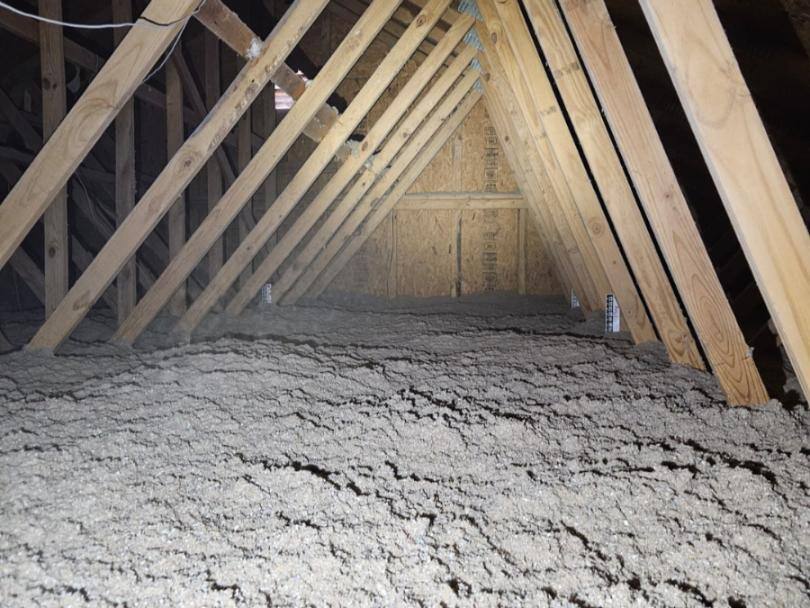Search for topics or resources
Enter your search below and hit enter or click the search icon.

If you are looking for attic insulation, you’ve likely learned about blown-in products. Both blown-in cellulose and blown-in fiberglass are used to insulate attic floors. But what R-value does a blown-in insulation offer? Will the R-value be enough?
South Central Services has insulated hundreds of new and existing homes in and around Greencastle, Pennsylvania. Blown-in insulation can have a variety of R-values, and what R-value you need depends on where you live.
By the end of this article, you will understand:
R-value, or resistance value, is one of the standard measurements of insulation performance. R-value explains how much conductive heat transfer a material can resist. The higher an insulation’s R-value, the more direct heat transfer it prevents.
The R-value of blown-in insulation varies by its installation depth. One inch of blown-in cellulose has a lower R-value than 7 inches of blown-in cellulose.

In this way, blown-in products can achieve almost any R-value needed, provided there is enough space for the depth required.
This feature of blown-in insulation is also why blown-in must be topped off periodically. As the insulation settles, it loses R-value.
So, what R-value do you need for your attic? The R-value will depend on the climate zone you are living in.
The following recommendations are from ENERGY STAR.
Climate Zone 1 is quite humid and hot. This climate is closer to the equator and does not experience significant cold fronts during the winter season.
According to ENERGY STAR, these homes need blown-in attic insulation to meet R-30.
Climate Zones 2 and 3 make up a large portion of the South and Southwest. Depending on where you are living in these climate zones, you may experience dry heat or humid heat. Regardless, the predominant temperatures in these zones are warmer.
According to ENERGY STAR, for a home in Climate Zone 2 or 3, the minimum R-value is R-49.
As we travel further north, the weather patterns become more varied. Homes in Climate Zone 4 may see some snow in the winter, while homes in Climate Zones 6 through 8 are usually cooler or cold all year long.
According to ENERGY STAR, the minimum blown-in R-value upstairs should be R-60 for any of these homes.
Choosing the R-value of your attic insulation isn’t as simple as the ENERGY STAR recommendation. Building codes vary by jurisdiction. Requirements may be lower or higher in your area based on your unique geography and building codes.
Some areas do not have an energy code. In these cases, R-value is at the discretion of the builder or homeowner. Both comfort and cost should be considered when an energy code is not available. If you live in an area with more extreme temperatures, more insulation is recommended to offset home heating and cooling costs.
For example, some homes in Climate Zone 3 may call for an R-49 while others call for R-38 or less. The same is true for Climate Zones 4 through 8.
In our area of Pennsylvania, we are only required to install an R-49. Our team can still install R-60 in an attic, but R-49 meets building codes in our jurisdiction.
You can think of insulation like a coat. When the weather outside is chilly, you might opt for a light jacket. As it gets colder and colder out, you need a thicker and thicker coat. For homes in cooler climates, there is a much more significant temperature difference between inside the house and outside.
By having a high R-value and an airtight seal upstairs, heat cannot press from your attic floor into your air-conditioned home in the summer. Heat also cannot escape into the attic and through the roof in the winter.
Blown-in insulation can have a variety of R-values, depending on the amount of insulation installed. Depending on your climate zone, your attic will have a minimum expected R-value between R-30 and R-60. Homes in colder climates need more blown-in insulation because they require a higher R-value.
Now that you know how to find the blown-in R-value your home needs, your next step is to:
Disclaimer: While we strive to publish information accurate to building science, local building codes and standards supersede our recommendations.
Kilian has co-owned and operated South Central Services for 8 years. He is passionate about community involvement. In his spare time, he enjoys being with his family, playing ice hockey, and going fishing with friends.
Topics: